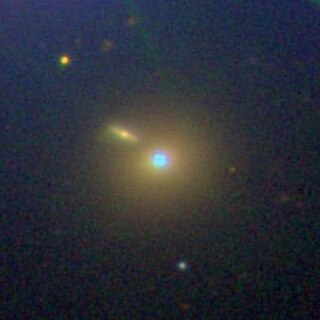
A quasar is an extremely luminous active galactic nucleus (AGN). It is sometimes known as a quasi-stellar object, abbreviated QSO. The emission from an AGN is powered by a supermassive black hole with a mass ranging from millions to tens of billions of solar masses, surrounded by a gaseous accretion disc. Gas in the disc falling towards the black hole heats up and releases energy in the form of electromagnetic radiation. The radiant energy of quasars is enormous; the most powerful quasars have luminosities thousands of times greater than that of a galaxy such as the Milky Way. Quasars are usually categorized as a subclass of the more general category of AGN. The redshifts of quasars are of cosmological origin.

The Kardashev scale is a method of measuring a civilization's level of technological advancement based on the amount of energy it is capable of using. The measure was proposed by Soviet astronomer Nikolai Kardashev (1932–2019) in 1964 and was named after him.

A blazar is an active galactic nucleus (AGN) with a relativistic jet directed very nearly towards an observer. Relativistic beaming of electromagnetic radiation from the jet makes blazars appear much brighter than they would be if the jet were pointed in a direction away from Earth. Blazars are powerful sources of emission across the electromagnetic spectrum and are observed to be sources of high-energy gamma ray photons. Blazars are highly variable sources, often undergoing rapid and dramatic fluctuations in brightness on short timescales. Some blazar jets appear to exhibit superluminal motion, another consequence of material in the jet traveling toward the observer at nearly the speed of light.

A BL Lacertae object or BL Lac object is a type of active galactic nucleus (AGN) or a galaxy with such an AGN, named after its prototype, BL Lacertae. In contrast to other types of active galactic nuclei, BL Lacs are characterized by rapid and large-amplitude flux variability and significant optical polarization. Because of these properties, the prototype of the class was originally thought to be a variable star. When compared to the more luminous active nuclei (quasars) with strong emission lines, BL Lac objects have spectra dominated by a relatively featureless non-thermal emission continuum over the entire electromagnetic range. This lack of spectral lines historically hindered identification of the nature and distance of such objects.

3C 279 is an optically violent variable quasar (OVV), which is known in the astronomical community for its variations in the visible, radio and x-ray bands. The quasar was observed to have undergone a period of extreme activity from 1987 until 1991. The Rosemary Hill Observatory (RHO) started observing 3C 279 in 1971, the object was further observed by the Compton Gamma Ray Observatory in 1991, when it was unexpectedly discovered to be one of the brightest gamma ray objects in the sky. It is also one of the brightest and most variable sources in the gamma ray sky monitored by the Fermi Gamma-ray Space Telescope. It was used as a calibrator source for Event Horizon Telescope observations of M87* that resulted in the first image of a black hole.

NGC 300 (also known as Caldwell 70) is a spiral galaxy in the constellation Sculptor. It is one of the closest galaxies to the Local Group, and probably lies between the latter and the Sculptor Group. It is the brightest of the five main spirals in the direction of the Sculptor Group. It is inclined at an angle of 42° when viewed from Earth and shares many characteristics of the Triangulum Galaxy. It is 94,000 light-years in diameter, somewhat smaller than the Milky Way, and has an estimated mass of (2.9 ± 0.2) × 1010M☉.

BL Lacertae or BL Lac is a highly variable, extragalactic active galactic nucleus. It was first discovered by Cuno Hoffmeister in 1929, but was originally thought to be an irregular variable star in the Milky Way galaxy and so was given a variable star designation. In 1968, the "star" was identified by John Schmitt at the David Dunlap Observatory as a bright, variable radio source. A faint trace of a host galaxy was also found. In 1974, Oke and Gunn measured the redshift of BL Lacertae as z = 0.07, corresponding to a recession velocity of 21,000 km/s with respect to the Milky Way. The redshift figure implies that the object lies at a distance of 900 million light years.

Markarian 421 is a blazar located in the constellation Ursa Major. The object is an active galaxy and a BL Lacertae object, and is a strong source of gamma rays. It is about 397 million light-years to 434 million light-years (133Mpc) from the Earth. It is one of the closest blazars to Earth, making it one of the brightest quasars in the night sky. It is suspected to have a supermassive black hole (SMBH) at its center due to its active nature. An early-type high inclination spiral galaxy is located 14 arc-seconds northeast of Markarian 421.

AGILE was an X-ray and gamma ray astronomical satellite of the Italian Space Agency (ASI). Launched in 2007, it de-orbited in February 2024.

3C 454.3 is a blazar located away from the galactic plane. It is one of the brightest gamma ray sources in the sky, and is one of the most luminous astronomical object ever observed, with a maximum absolute magnitude of -31.4. It has the brightest blazar gamma ray flare recorded, twice as bright as the Vela Pulsar in the Milky Way galaxy. It also flares at radio and visible wavelengths – in red light, the blazar brightened by more than 2.5 times to magnitude 13.7 – and it is very bright at high radio frequencies.
The Whole Earth Blazar Telescope (WEBT) is an international consortium of astronomers created in 1997, with the aim to study a particular category of Active Galactic Nuclei (AGN) called blazars, which are characterized by strong and fast brightness variability, on time scales down to hours or less.

Markarian 501 is a galaxy with a spectrum extending to the highest energy gamma rays. It is a blazar or BL Lac object, which is an active galactic nucleus with a jet that is shooting towards the Earth. The object has a redshift of z = 0.034.

GRB 130427A was a record-setting gamma-ray burst, discovered starting on April 27, 2013. This GRB was associated to SN 2013cq, of which the appearance of optical signal was predicted on May 2, 2013 and detected on May 13, 2013. The Fermi space observatory detected a gamma-ray with an energy of at least 94 billion electron volts. It was simultaneously detected by the Burst Alert Telescope aboard the Swift telescope and was the brightest burst Swift had ever detected. It was one of the five closest GRBs, at about 3.6 billion light-years away, and was comparatively long-lasting.
Fermi's Large Area Telescope (LAT) recorded one gamma ray with an energy of at least 94 billion electron volts (GeV), or some 35 billion times the energy of visible light, and about three times greater than the LAT's previous record. The GeV emission from the burst lasted for hours, and it remained detectable by the LAT for the better part of a day, setting a new record for the longest gamma-ray emission from a GRB.

Time-domain astronomy is the study of how astronomical objects change with time. Though the study may be said to begin with Galileo's Letters on Sunspots, the term now refers especially to variable objects beyond the Solar System. Changes over time may be due to movements or changes in the object itself. Common targets included are supernovae, pulsating stars, novas, flare stars, blazars and active galactic nuclei. Visible light time domain studies include OGLE, HAT-South, PanSTARRS, SkyMapper, ASAS, WASP, CRTS, GOTO and in a near future the LSST at the Vera C. Rubin Observatory.

S5 0014+81 is a distant, compact, hyperluminous, broad-absorption-line quasar, or blazar, located near the high declination region of the constellation Cepheus, near the North Equatorial Pole.

SN 2018cow was a very powerful astronomical explosion, 10–100 times brighter than a normal supernova, spatially coincident with galaxy CGCG 137-068, approximately 200 million ly (60 million pc) distant in the Hercules constellation. It was discovered on 16 June 2018 by the ATLAS-HKO telescope, and had generated significant interest among astronomers throughout the world. Later, on 10 July 2018, and after AT 2018cow had significantly faded, astronomers, based on follow-up studies with the Nordic Optical Telescope (NOT), formally described AT 2018cow as SN 2018cow, a type Ib supernova, showing an "unprecedented spectrum for a supernova of this class"; although others, mostly at first but also more recently, have referred to it as a type Ic-BL supernova. An explanation to help better understand the unique features of AT 2018cow has been presented. AT2018cow is one of the few reported Fast Blue Optical Transients (FBOTs) observed in the Universe. In May 2020, however, a much more powerful FBOT than AT 2018cow was reportedly observed.
TXS 0506+056 is a very high energy blazar – a quasar with a relativistic jet pointing directly towards Earth – of BL Lac-type. With a redshift of 0.3365 ± 0.0010, it has a luminosity distance of about 1.75 gigaparsecs. Its approximate location on the sky is off the left shoulder of the constellation Orion. Discovered as a radio source in 1983, the blazar has since been observed across the entire electromagnetic spectrum.

AP Librae is a BL Lacertae object located at a distance of 700 million light years in the southern constellation of Libra. In the visual band it is one of the most active blazars known. AP Lib is surrounded by an extended source with a spectrum characteristic of a red-shifted giant elliptical galaxy. The derived visual magnitude of this region is 15.0, and it follows a radially decreasing brightness that is characteristic of an elliptical. Seven fainter galaxies are visible within an angular radius of 9′, suggesting it is the brightest member of a galactic cluster.

3C 345 is a blazar/flat spectrum radio quasar located in the constellation of Hercules. It is noted for hosting a superluminal jet and its variability in almost all wave bands.

The Byurakan Conference was held at the Byurakan Astrophysical Observatory in Armenia in 1964, at the initiative of the young scientist Nikolai Kardashev. It brought together a large number of Soviet astronomers and astrophysicists to take stock of knowledge and results in the search for traces of extraterrestrial life. The possibility of detecting extraterrestrial civilizations with the instruments available at the time was also discussed, as well as the criteria for communication with extraterrestrial intelligence.


















